Mollusks in the ocean, commonly known as seashells. There are not only many types of seashells, but they are also widely distributed. They can be found in three sea areas: cold, warm and hot, and at three water depths: upper, middle and lower. Although seashells have different shapes, colors, and living habits, in general, their common feature is that their bodies are soft and unsegmented, consisting of five parts: head, feet, internal organs, mantle, and shell.
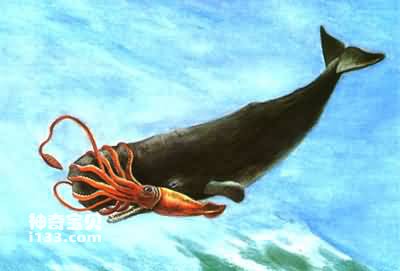
Chapter Fighting with a Whale
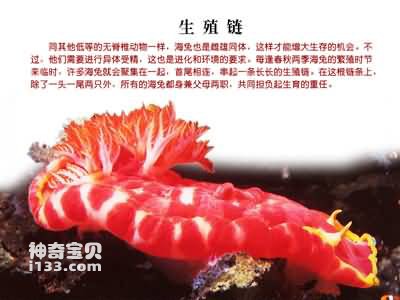
Aplysia a reproductive chain
Because seashells are closely related to people’s lives, everyone is no stranger to them. For example, the scallop is shaped like a fan; the tiger-spotted baby is named after the tiger-like spots on its shell. Tridacna clam, known as the "King of Shells"; agate shell, a rare treasure in the world; white jade shell, as white as magnolia; sun and moon shell, as white as silver; and mother-of-pearl, pearl oyster, mussel, There are no less than 100,000 species of sand clams, flower clams, Shih Tzu tongues, clams, oysters, rice snails, horn snails, umbrella snails, etc. Just by hearing these unique names, you will know how beautiful the colorful and varied seashells are.
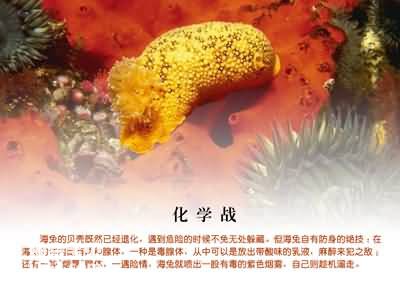
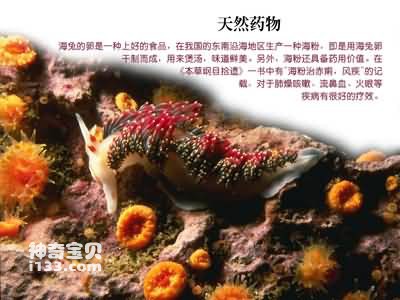

1. Red snail
There are two types of red snails, one is larger and is found along the coasts of the south and north, and is called red snails; the other is smaller and is only found along the southern coast, and is called wrinkled red snails. They are all species that live on shallow sea mud beaches. Their meat, especially the muscles of their feet, is thick and, like abalone, it is also a good seafood.
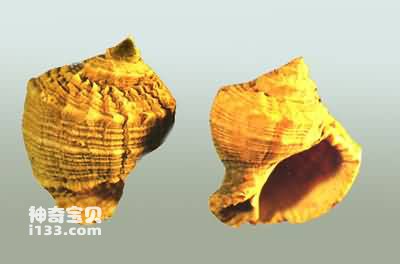
The shell of red snail is spherical, with thick shell and ribs and spinous processes on the surface. The inner surface of the shell mouth is very smooth and orange-red, so it got the name red snail.
In addition to the edible meat of red snails, the shells are also very useful. Smoking sets or other small handicrafts made from it in shell carving factories are very popular. People who first come to the beach like to find a few red conch shells as souvenirs.
Many snails similar to red snails, commonly known as bone snails, have strangely shaped shells: some have extremely long front grooves, like elongated beaks; some have many knob-like protrusions on their surface; some have long There are long thorns or thorns, and they are really full of weird shapes. Although their shells are not as bright and colorful as those of baby cones and cones, they are also a type that people like to collect.

2. Luminous Salamander Snail
Luminous salamander snails are molluscs in the gastropod class. Their meat is edible and their shells can be used as shellfish. They are distributed in the subtidal zones of my country's Paracel Islands, Hainan Island, Taiwan Island and other places.
3. Tridacna
Tridacna, also called Chequ, is a type of large marine bivalve distributed in the Indian Ocean and the Western Pacific. There are only 6 species reported in the world, all living in coral reef environments in tropical waters. Such animals are also found in my country's Taiwan, Hainan, Paracel Islands and other South China Sea islands. Their shells are large and thick, with rough shell surfaces and raised radial ribs and intercostal grooves. Some species have thick scales on their ribs.
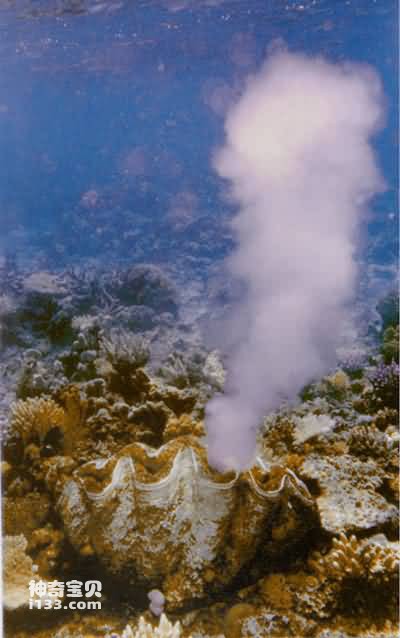
Tridacna living in the sea, when the tide rises and submerges it, it opens its shell and stretches out the edge of its thick mantle to move around. Their mantles are extremely colorful, not only in bright colors such as peacock blue, pink, emerald green, brown and red, but also often in various patterns.
Tridacna, like other bivalves, also brings food in through seawater flowing through its body. But not only do they feed in this way, they also have the ability to grow food in their own tissues. They live in symbiosis with a single-celled algae, zooxanthellae, and use this algae as supplementary food. Under special circumstances, zooxanthellae can also become the main food of Tridacna clams.
Tridacna and zooxanthellae have a symbiotic relationship, which is beneficial to each other. Zooxanthellae can fully reproduce by taking advantage of the convenient conditions provided by the clam's mantle, such as space, light and phosphorus, nitrogen and carbon dioxide in metabolites; the clam can use zooxanthellae as food. The reason why the clam grows so huge is because it can get food from two sources.
Tridacna is the largest species of bivalves, with the largest shell length up to 1.8 meters and weight up to 500 kilograms. A single shell can be used as a bathtub for a baby. Tridacna shells can be made into various utensils and their meat can be eaten.
4. Razor clams
On the coastal mudflats, there lives a kind of bivalve called "razor clam". It likes to live near estuaries where fresh water flows in. It is a common mollusk along the coast of my country.
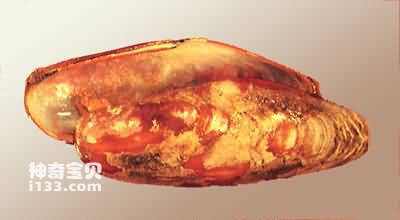
Short stone clam
The meat of razor clams is delicious and the price is very cheap, so it is a popular seafood. In my country's coastal areas, especially in Zhejiang and Fujian provinces, artificial methods are used to breed it.
Because they live on soft mudflats, the two shells of razor clams are very thin and brittle. The shell is almost rectangular in shape and often has a thin layer of light green skin growing on its surface.
The razor clam has two well-developed water pipes. It relies entirely on these two water pipes to maintain contact with the seawater on the beach. It sucks in food and fresh seawater from the inlet pipe, and discharges waste and sewage from the drainage pipe.
Razor clams live in burrows on soft mudflats, and the depth of their burrows varies with the season: summer is warm and their burrows are shallow; winters are cold and their burrows are deeper. The depth of lurking usually is about 5-6 times the body length, and the deepest can reach 40 cm, which is about 10 times the body length. If we see two small holes not far apart on the beach and a little seawater spurts out when touched with a long hook, then there must be razor clams underneath. These two small holes are where the two water pipes of the razor clam stick out. The size of a razor clam can be calculated from the distance between the two holes. Its body length is about 2.5-3 times the distance between the two holes.
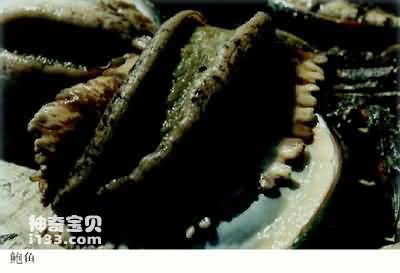
5. Abalone
The meat of abalone is very delicious and it is a valuable seafood. But it is not a fish, but a single-valve mollusk that crawls on rocks below the low-tide line in shallow seas.
The body of the abalone is covered with a thick calcareous shell, which is a right-handed spiral shell in the shape of an ear. Its Latin literary name can be called "sea ear" in literal translation, because Its shell is shaped like an ear.
The feet of abalone are particularly thick and divided into upper and lower parts. There are many antennae and hillocks on the upper feet, which are used to sense the external situation; the lower feet are oval-shaped when extended, with a flat belly, suitable for attachment and crawling. When we eat abalone, we mainly eat the muscles of its feet.
Abalone lives in rocky areas with fast currents and luxuriant seaweed. They like to inhabit coastal islands or protruding rocky corners from the coast. Abalone mostly crawls in the cracks of rocks or caves. The water depth in which they are distributed varies with the species. For example, the Panda abalone in northern my country is generally distributed in water depths of more than 10 meters. In winter, it moves deeper to avoid the cold. The depth can reach up to 30 meters. In spring they slowly move up, and some can live several meters below the tide line.
Abalone likes to eat brown algae or red algae. For example, abalone likes to eat wakame, young kelp and sargassum. The food intake of abalone changes with the seasons. Generally, abalone eats more in seasons with higher water temperature; in winter, it is less active and eats less.
There are many types of abalone and they are widely distributed. Abalone is distributed along the coast of my country. In the north, Dalian and Changshan Island produce more abalone, and the ones they produce are Panda abalone, which are larger and ovoid in shape. In the South China Sea, variegated abalone and eared abalone are produced. Variegated abalone and large abalone are similar in shape, but smaller in size; eared abalone is longer in shape, and its shells are more like ears. The meat on its feet is the thickest, and shells usually cannot Completely wrap it up in it.
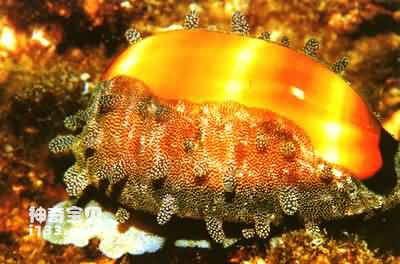
6. Baby
Among the marine shellfish, there are many kinds of shells with very beautiful luster. Whether in ancient times or modern times, people love them very much. Among these species, the most famous is the baby. In ancient times, when there was no gold or currency, people used these precious shells as currency. Therefore, from hand to hand, all valuable and rare things are called treasures. Baby is a single-shelled shellfish that mostly lives in tropical and subtropical oceans. Many kinds of treasures can be found along the coasts of my country's Fujian, Taiwan, Guangdong, Hainan and Dongsha and Xisha Islands. Baby shells are generally nearly oval, with a very smooth shell surface, and have various patterns depending on the species. They are very beautiful, like artificially made works of art.
Why is the baby so shiny? We can explain this problem from the baby's living conditions.
Like other shellfish, babies also live a crawling life. When it crawls, its head and feet protrude from the shell mouth. Except for the head and feet, the mantle on the edge of the baby wraps the entire shell upward from both sides of the shell's ventral surface. In this way, when the baby moves, the shell is always surrounded by the turned-out mantle, which can often secrete enamel to make the shell shiny.
There are many types of treasures, and more than 40 species have been found along the coast of my country. One of the most commonCalled Huo Mu, this is a small treasure. The shell is oval, light yellow or golden yellow, and often has two gray horizontal stripes on the back, which is extremely bright. This kind of treasure was used as currency in many areas in ancient times. The word "贝" we write now is created according to the shape of this treasure. The distribution range of clams is limited to tropical sea areas. It is common in southern Hainan Province, Xisha Islands and other places in my country. After the tide goes out, it can be easily found on coral reefs. Another common treasure is called the slow shell. This is a medium-sized treasure. The shell is light brown, with crisscross brown stripes and star-shaped spots on it. There are purple-brown spots on both edges and stars.
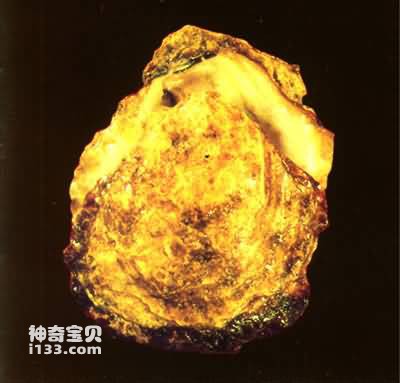
7. Oyster
Oyster is also called oyster yellow and sea oyster. Its meat is delicious and has high nutritional value, so people not only harvest naturally growing species, but also find ways to artificially breed certain species. Together with mussels, scallops, mud clams, etc., it is an important object of marine aquaculture and plays an important role in the production of seafood. At present, the annual output of oysters in the world has exceeded 1 million tons, which shows that everyone attaches great importance to it. There are about 20 kinds of oysters produced along the coast of my country. The most common 5 species include dense-scale oyster, Omi oyster, pleated oyster, long oyster and Dalian Bay oyster.
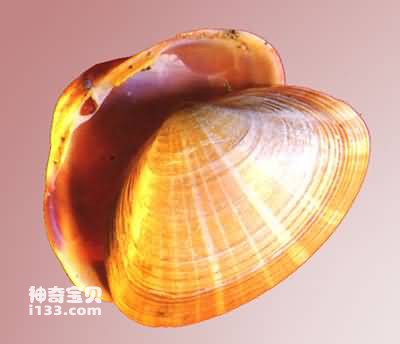
8. Clams
Located on the Shandong Peninsula and on the shores of Jiaozhou Bay, Qingdao is a famous coastal city with beautiful scenery. The unique seafood product of Qingdao is clams.
The Chinese name of the clam is variegated clam. It is mainly produced in Jiaozhou Bay near Qingdao. It inhabits the muddy beach seabed below the middle and lower areas of the intertidal zone, and is most produced below the dry tide line. The depth of its habitat in the sand is generally no more than twice its body length. On every first and fifteenth day of the lunar calendar, after low tide, people often go to the beach to dig for this seafood to satisfy their cravings. For mass production, clam dredging boats are used to collect clams in deep water.
Clams not only taste delicious, but also have comprehensive nutrition. They are really high-quality and low-priced seafood. It contains protein, fat, carbohydrates, iron, calcium, phosphorus, iodine, vitamins, amino acids, taurine and other ingredients. It is a low-calorie, high-protein food that can prevent and treat chronic diseases in middle-aged and elderly people.
Clams are salty and cold in taste, and have the functions of nourishing yin and moistening dryness, diuresis and swelling, and softening and dispersing stagnation. "Compendium of Materia Medica" records: "The nature of clams is moisturizing and helps with body fluids, so it can moisten the five internal organs, quench thirst, and whet the appetite." Salt can enter the blood and soften hardness, so blood clots and senile syndrome in housewives are caused by cold and heat. "Nowadays, in addition to this traditional use, the clam tissue is chemically extracted, and the extract is called clamin. Animal experiments have proven that clams have inhibitory and alleviating effects on sarcoma and ascites tumors in mice.
Modern medicine believes that clam meat stewed and eaten three times a day can cure diabetes; clam meat and leeks eaten regularly can treat thirst, dry cough, upset, and hot palms and soles caused by yin deficiency. Regular consumption of clams is also effective in treating goiter, jaundice, poor urination, and abdominal distension.

9. Eggs in the sea - mussels
Mussels are called Haihong in northern my country, and their dried meat is called Danlai. There are many types of mussels, and there are more than 30 types along the coast alone. The species with greater economic value are: purple mussels, thick-shelled mussels and emerald mussels. The common and cultivated mussels along the northern coast of my country are mainly purple mussels.
The clam lives by attaching itself to rocks or other objects by its byssus, and can crawl around in a small area. Mussels have a strong ability to adapt to the environment and are therefore widely distributed. It is distributed along the coast from north to south in my country.
The nutritional value of mussels is very high. If the nutritional index of eggs is set as 100, then scallops are 92, shrimps are 95, beef is 80, and mussels are 98. Because the nutritional index of mussels is so high, people call mussels "eggs in the sea."
According to Li Shizhen's "Compendium of Materia Medica" in the Ming Dynasty, mussels can treat diseases such as consumptive consumption, exhaustion, lack of essence and blood, vomiting blood and diarrhea, bowel sounds and low back pain. They are also effective in treating women's diseases and are also a tonic for women after childbirth. According to foreign reports, mussels contain nutrients necessary for patients with arteriosclerosis and the elderly, and can prevent endemic diseases and thyroid abscesses. The pharmacological value of mussels is inseparable from its high nutritional value. For this reason, mussels have always been a cultivated shellfish worldwide. my country's mussel farming experiments began in 1958 and were successful.
The artificial breeding method of mussels refers to using temperature or shade stimulation to induce brood mussels to lay eggs during the spawning period, and then the hatched larvae are cultured in an indoor water tank. The larvae can attach to the seedling attachment in about 20 days. Mussel farming generally adopts a raft-type suspension farming method similar to kelp farming. Seedlings are usually packed in August and harvested when they reach 5-8 cm in mid-March of the following year. At present, the cultivation method of mussels and kelp is being tried on the northern coast. The excrement of mussels provides fertilizer for kelp, and the growth of kelp improves the living environment of mussels. The mussel farming area in my country reaches more than 2,000 hectares. The total output can reach 60,000 tons, ranking first in shellfish farming output.
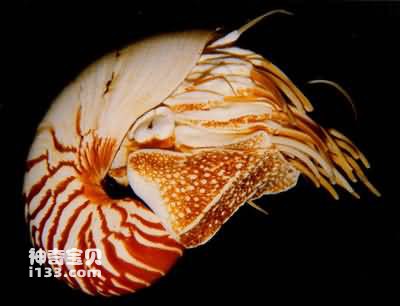
10. Nautilus
Nautilus belongs to the four-branched class Cephalopod. Ancient cephalopods, like parrots, had shells of different shapes. But now most of them are extinct, and the only one left is the nautilus living on the seabed. Therefore, the nautilus is a "living fossil" and a nationally protected animal. It has long been a valuable tool in the systematic study of animal evolution. one of the materials.
The nautilus is a benthic animal that usually crawls on the bottom of the sea and occasionally floats and swims in the sea. Its swimming method is similar to that of a squid, using its two funnels that are wrapped around each other to spray water. The nautilus has a lot of tentacles, 90 in total. Two of them become very fleshy together, and when the flesh is shrunk into the shell, they cover the mouth of the shell, which is equivalent to the role of the gastropod seal. There are only three kinds of nautilus living in the world, and the number is not large. Their shells are very beautiful and have thick nacre, which can be enjoyed or made into handicrafts.

11. Scallops
Scallops are one of the famous seafood treasures along the coast of Shandong, my country, especially the scallops produced in the Changshan Islands in the Bohai Sea. As the name suggests, scallops are named because their shells are shaped like folding fans. Because it lives in the sea, people also call it "sea fan".
Scallops usually live on rocks or sandy seafloor with their byssal threads. When people collect them from the sea and move them into aquariums, they become very active in a short period of time due to the stimulation of the new environment. Sometimes the adductor muscle is stretched, and the two scalloped shells open accordingly. The tentacles on the edge of the mantle stretch out of the shell like rays of sunlight, which is very beautiful; sometimes the adductor muscle is contracted to close the shell. Due to the rapid expansion and contraction of the adductor muscle, the shell opens and closes rapidly, and the discharged water produces a large recoil effect. Scallops use the reaction force generated by the discharged water to swim quickly in the water, especially young scallops. They can "fly" from the bottom of the aquarium out of the water in an instant, and sometimes they can "fly" to the outside of the aquarium. Therefore, people say they can "fly". Of course, this kind of "flying" performance of shellfish cannot last for a long time. After they adapt to the new environment, they lie quietly on the bottom of the water and stick to the bottom of the water tank with their byssus, and start a peaceful life. .
The dried product of the tender and large adductor muscles of scallops is the precious seafood - scallops, so it is also known as "scallop clams".
Scallops have tender meat, delicious taste, and are rich in protein, inorganic salts and multiple vitamins. They are valuable seafood treasures. Scallops are not only of high edible value, but also have extremely high medicinal value. It is reported that the extract from its ligaments has certain efficacy in treating cancer.
Precisely because of the high economic value of scallops, artificial breeding has been carried out in various maritime countries around the world. The main species cultured along my country's coast are Chlamydia scallops and Chlamydia chinensis scallops.
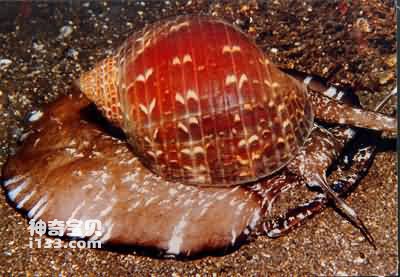
12. Partridge and quail snail
Quail snail. Distributed in intertidal waters in Xisha, Taiwan and other places in my country.
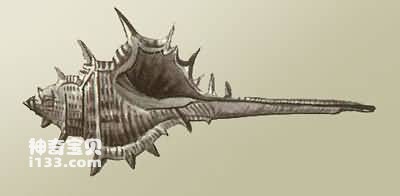
13. Shallow seam murex
The spiral layer is about 8 layers. Sutures are shallow. Each whorl has 3 longitudinal ribs. There is one sharp spine in the middle of each longitudinal rib in the whorl; there are three principal spines on the longitudinal ribs in the whorl layer, and some of them have one short spine. There are 5 to 7 thin swollen ribs between the longitudinal swollen ribs in the whorl layer. The ribs on the shell surface are thin and raised.
The surface of the shell is yellow-gray or yellow-brown. The anterior groove is very long, almost in the shape of a closed tube, and the spikes on it usually do not exceed 1/2 of the length of the anterior groove. Horny.
Warm seafood. Lives in sandy and muddy seabed tens of meters deep. It is a common type of bottom trawl. Distributed along the coast south of Zhejiang, my country, and also in Japan.
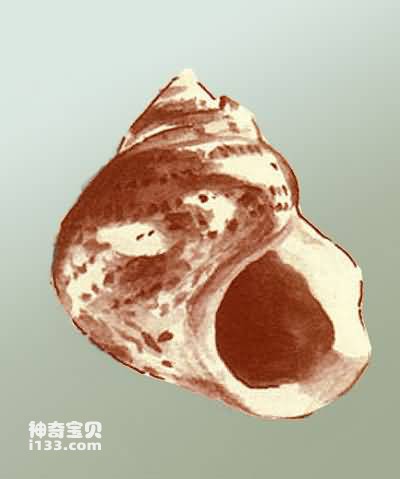
14. Salamander snail
The chitin is strong. There are about 6 spiral layers. Suture lines are obvious. The top of the shell is slightly pointed. The body whorl is wide. The shell surface is swollen and smooth, with fine growth lines. The shell color is bright and colorful. The top of the shell is pink or purple. The shells are usually light yellow or brown in color, with brown or green ribbons and yellow-white markings on the ribbons. The shell mouth is round and the inside is white with pearl luster. The outer lips are simple and the inner lips are thick. No navel. It's limestone.
Warm seafood. It inhabits rocks and coral reefs in shallow water with a depth of 5 to 20 meters. Found in my country's Paracel Islands, and distributed in the western Pacific and central Pacific south of Amami, Japan.
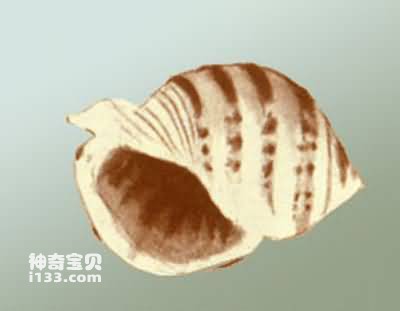
15. Double grooved snail
Also known as ball snail. The shell is small and slightly spherical. The shell surface is swollen and light brown. The spiral part is slightly raised. The shell surface has vertical and horizontal rows of thin ribs. Body whorl block. The inner surface of the shell mouth is white or light brown. The outer lip is thick and rolled back, with rib-like teeth on the inner edge; the lower part of the inner lip is slightly expanded to form a sheet-like surface with well-developed rib-like teeth. The front groove is wide and short, twisting dorsally. The navel is small. The skin is horny, thin and small.
Lives in shallow sandy or muddy sea bottoms. Found in the East China Sea and South China Sea, and also distributed in Japan, the Philippines, and Indonesia.
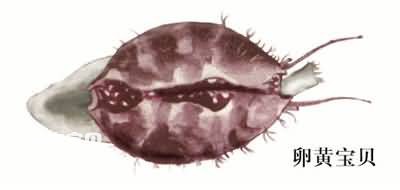
16. Egg yolk baby
The shell is oval in shape, with a rounded back and a slightly pointed front end. The surface is smooth with porcelain luster, yellowish brown or grayish yellow, with milky white spots and 3 inconspicuous brown bands. There are fine lines on both sides of the shell that extend to the base. The spiral part is covered with enamel. The base is light brown. The shell mouth is narrow and long. There are about 24 to 32 outer labial teeth and about 20 to 27 inner labial teeth. The inner surface of the shell is white or lavender.
Lives among rocks and coral reefs near the low tide line. It is produced in Taiwan and the South China Sea coast of my country, and is also distributed in Japan and the Philippines.
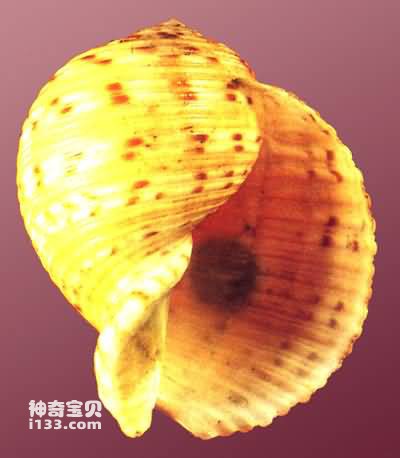
17. Chinese quail snail
The shell is slightly spherical. The spiral part is low. The whorl layer of the body is enlarged. Light yellow. There are about 7 spiral layers. The shell has well-developed and broad flat ribs. There are 1 or 2 lighter-colored whelk ribs with brown patches on every one or two ribs. The shell mouth is semicircular, the inside is brown, and it is carved with deep ribs. The outer lip is thin and notched at the edge; the lower part of the inner lip is rolled outwards and forms a false umbilicus with the screw axis. The front groove is wide and short, twisting dorsally. No hens.
Lives in shallow sandy or muddy sea bottoms. Found in the East China Sea and South China Sea in my country, and also distributed in Japan.
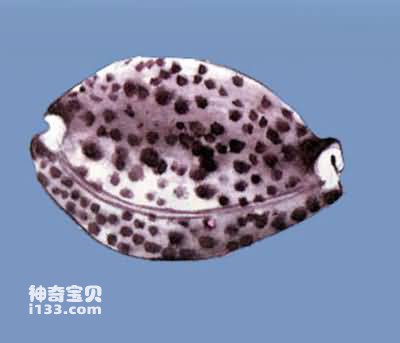
18. Tabby baby
The shell is larger, oval, with a rounded back, slightly convex ends, and a thin front end. The top of the shell is sunken inward. The shell surface is smooth, with a porcelain luster, light yellow or white, and covered with dark brown spots of different sizes, resembling the markings of tiger skin, hence the name. The spiral part is covered by enamel and the dorsal line is obvious. The base is milky white. There is a dark brown mark later in the middle of the inner lip. The shell mouth is narrow and long. There are about 24 to 30 outer labial teeth and about 22 to 26 inner labial teeth. The inner surface of the shell is white.
Lives on subtidal rocks or coral reefs. Found in Taiwan, Guangdong, Hainan and the Paracel Islands in my country. It is a widely distributed species in the tropical sea areas of India and the western Pacific. The shell is for viewing.
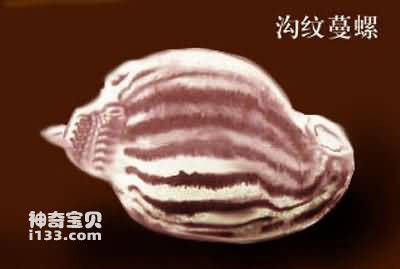
19. Grooved snail
The shell is oval, yellow-white, with wide longitudinal reddish-brown wavy patterns. There are about 9 spiral layers. The spiral part is short, with vertical and horizontal thin ribs, and crosses to form granular protrusions. Sometimes there are vertical and swollen ribs. The body whorl layer is enlarged, and there are developed longitudinal ribs on the left side of the ventral surface. The shell mouth is long and narrow. The outer lip is thick and rolled outwards, and the inner edge has toothed ribs; the lower part of the inner lip extends into a sheet shape and has many irregular ribs. The front groove is wide and short, curving dorsally. Horny.
Lives in sandy bottoms from low tide areas to shallow seas. Found on the east and south coasts of my country, and also distributed in Japan.
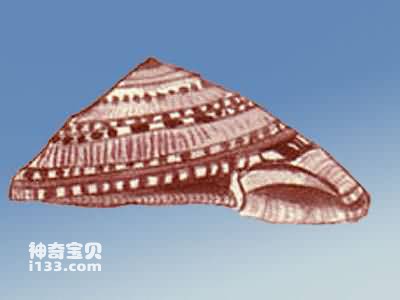
20. Big wheel snail
The shell is low conical, solid, yellowish brown or bluish gray, with light yellowish brown skin. There are about 9 spiral layers. The top of the shell is low. The width of each layer increases rapidly. There are 4 beads-shaped whorl ribs in the spiral part and 5 in the body whorl layer. The ribs vary in width. The sutures are deep and groove-like. There are reddish-brown and white spots on the upper and lower ribs along the suture line. Shell base flat. The navel is large and deep. There are spiral ribs with tooth-like notches on the periphery of the umbilicus, and there are 2 deeper spiral grooves on the periphery of this rib. Horny.
Lives on the muddy and sandy bottom of shallow seas. Found along the coasts of Guangdong and Hainan, and also in Japan, Java and Sri Lanka.
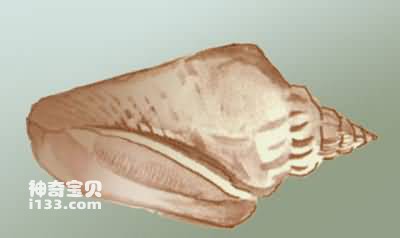
21. Iron-spotted wind snail
The shell is small, strong, yellowish-white, with brown spots. There are about 8 spiral layers. The middle part of each whorl layer and the upper part of the body whorl layer expand to form a shoulder angle, and there are nodular protrusions on the shoulder angle. The whorl layer is slightly enlarged, with 2 incomplete olive-colored bands. The shell mouth is fusiform, the inner surface is brown, engraved with many grooves, and the outer edge has a purple-brown border. The edge of the outer lip is thickened and curved near the posterior end to form an edge. The front notch is shallow. The inner lip is close to the shell shaft. The front groove is short. It is leaf-shaped, horny, with teeth on one side.
Lives on sandy beaches near the low tide line. Found in Taiwan and the coast of the South China Sea. It is a common species in tropical areas of the western Pacific.
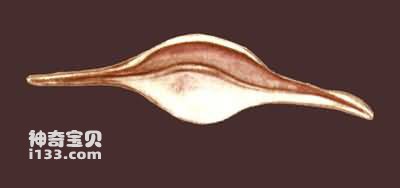
22. Triton snail
The shell is spindle-shaped, with the front and rear ends extending into a sword shape, and the middle part is oval. The shell is flesh-colored and shiny. The shell has circular grooves, and the circular patterns on the sword-like protrusions at both ends are more obvious. The shell mouth is narrow and long, slightly wider below. The outer lip is thicker and curved; the inner lip is thin and rounded in the middle. The anterior and posterior grooves are extremely long and semi-tubular, with the tips slightly tilted back.
Live in shallow sea. Found in the South China Sea, it is also found in Malaysia, Japan, and Australia.

23. Chlamydia scallops
Commonly known as sea fans and scallops. The dried adductor muscle product is called scallop. Shell round fan shape. Shell height is slightly greater than shell length. The right shell is relatively flat and the left shell is slightly convex. Hinge straight, medium top. The left shell has about 10 thick ribs, and the right shell has about 20 thicker ribs. Both shell ribs have irregular growth spines. The front ears are larger than the back ears. The shell surface is light brown, purple-brown, orange, red and off-white. The outer ligament is thin and the inner ligament is well developed. The byssus hole is located on the ventral surface of the front ear of the right shell, and has 6 to 10 thin ctenoid teeth.
Inhabits the seabed from the low tide line to more than 60 meters or deeper. Attached to rocks or shells by byssus. Distributed in the Yellow and Bohai Seas, it is also distributed in Korea and Japan. Scallops are rich in nutrients. Shells can be used as raw materials for shell carving. It is an artificially bred species.
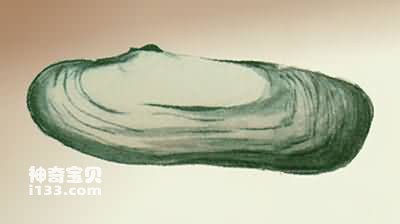
24. Razor clam
The shell is elongated, the dorsal and ventral edges are nearly parallel, and the front and rear ends are rounded. The top of the shell is located on the dorsal edge, slightly forward. external ligament. The growth lines are obvious. There is a slightly concave trench from the top of the shell to the ventral edge slightly in front of the center of the shell. The shell surface is covered with a yellow-green skin. The inner surface of the shell is white. There is a protrusion below the top of the shell corresponding to the groove on the shell surface. The hinge is small, with 2 main teeth on the right shell and 3 main teeth on the left shell.
Buried shellfish. Lives in estuaries or inner bays where a small amount of fresh water flows in. It is widely distributed along the coast of my country and also in Japan. The meat is delicious and is an important cultivated shellfish in my country.

25. Ground cone snail
The shell is cylindrical. The spiral part is slightly higher than the body whorl layer. There is an obvious row of nodular protrusions immediately above the suture line of each whorl layer and on the shoulder of the body whorl layer. There are about 10 nodular protrusions on the shoulder of the body whorl layer. The shell surface is smooth, light flesh-colored, and decorated with small brown mesh-like patterns. There is a wide intermittent purple-brown color band printed on each of the upper, middle and lower parts of the whorl layer. The shell mouth is long and narrow.
This animal has venom glands. Life is in danger if a person is accidentally bitten. It lives on sandy beaches or among coral reefs near the low tide line to a depth of several meters. Found in my country's Paracel Islands and southern Hainan, it is a warm water species widely distributed in the Indo-Western Pacific.
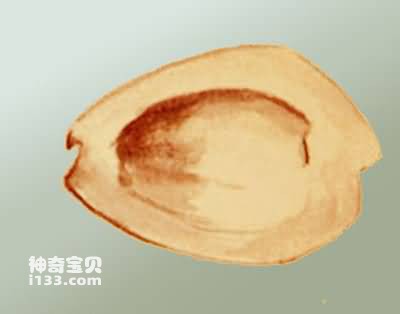
26. Huobei
The shell is small, the center of the back is raised, and the sides are lower and flat. Nodular protrusions are formed on both sides of the back of the shell. The spiral part is covered with enamel. Topline unclear. The shell surface is bright yellow, and the edges on both sides are lighter in color. There are 2 to 3 gray-green horizontal bands on the back. The base is flat, yellowish white. The shell mouth is narrow and long. The lips and teeth are thick and short, about 12 to 13 on each side. The inside of the shell is purple.
Lives among rocks and coral reefs in the intertidal zone to the subtidal zone. Found in Taiwan, the southern tip of Hainan and the Paracel Islands, it is a widely distributed species from India to the Western Pacific. In ancient times, shells were used as currency, hence the name.
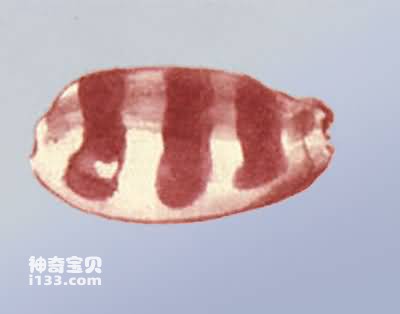
27. Brown-banded burnt clam
The shell is small and oval. The back is rounded and the edges on both sides are slightly thicker. The shell surface is smooth and porcelain-like, milky white, with 3 broad brown bands. The spiral part is covered with enamel. The base of the shell is pure white. The shell mouth is narrow, long and nearly straight. There are about 16 to 18 outer labial teeth and about 14 to 17 inner labial teeth. The inner surface of the shell is white.
Lives among rocks near the low tide line. Found in my country's Hainan and Xisha Islands, and also distributed in Japan and the Indian Ocean.
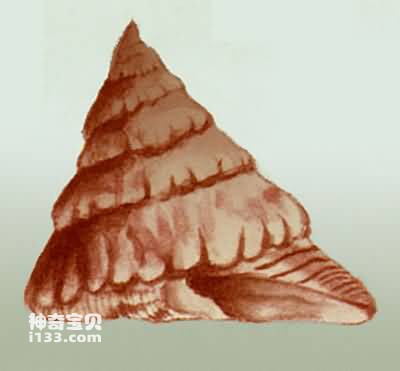
28. Large horseshoe snail
The shell is large, thick, and tapered. Shell top. The spiral part is large. The upper half of each whorl layer has 3 to 4 whorl ribs, and the whorl ribs are connected by many granular protrusions; the lower half of the whorl layer has a row of thick tumor-like protrusions above the suture line. The growth lines are clear. The shell is gray-white in color with pink and purple flame-like patterns. The shell surface has a layer of yellowish-brown shell skin. The bottom of the shell is flat. The shell mouth is inclined. The outer lip is simple; the inner lip is thick and twisted into an S shape. Horny.
Warm water species, living on coral reefs and rocks from low tide to a depth of several 10 meters. Distributed in Hainan, Xisha and Nansha Islands in my country, as well as Japan, Indochina Peninsula and other places. The shells can be used for crafts and the meat can be eaten.

29. Longitudinal rib textured snail
The shell has a short pointed cone shape. There are about 9 spiral layers. The sutures are deep. The spiral part is high. The shell has significant longitudinal ribs and fine threads, which are intertwined to form a cloth pattern. The upper end of the longitudinal rib is thicker. There are usually 1 to 2 thick vertical veins on each whorl layer. The shell surface is light yellow, mixed with brown cloud spots. The outer lip has a thick rim, and the inner edge usually has 6 tooth-like protrusions; the inner lip is thin. The anterior groove is short and deep, and the posterior groove is a small notch.
Inhabits the muddy and sandy seabed in the intertidal zone and subtidal zone. It is a common species along the coast of my country and is also distributed in Japan. The meat is edible.

30. Variegated pen snail
The shell is small, oval, and has a small spiral part. The spiral body layer is larger. The shell surface has weak whorls. The outer lip of the shell mouth is thick. There are discontinuous yellow stripes on the shell surface. The shell shaft and shell mouth are slightly purple.
Inhabits the rocks under the intertidal zone or the sandy bottom under the rocks. Found in the South China Sea of my country and also distributed in Japan.
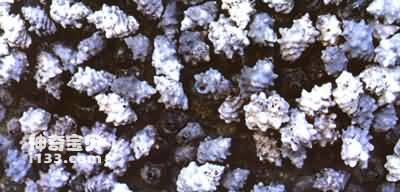
31. Lychee snail
A mollusk belonging to the class Gastropoda, distributed in the intertidal zones of the East my country Sea and South China Sea.
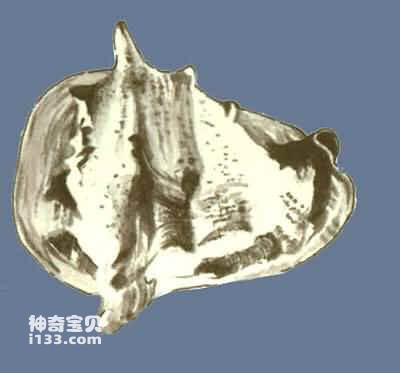
32. Crown snail
There is Tang Guanluo. The shell is large and thick, slightly spherical or oval, gray-white. The whorl is low. The whorl layer of the body is enlarged. There are three thick whorl ribs on the body whorl layer, and one on the shoulder has 5 to 7 angular protrusions. Delicious and long. The inner and outer lips expand into orange shields. There are 5 to 7 teeth on the inner edge of the outer lip. Delicious deep orange color inside the mouth. The anterior groove is short and twisted toward the rear.
It lives on the sandy seabed with a water depth of more than 1 to 20 meters. It is found in Taiwan and the Paracel Islands in my country and is also produced in Japan. The meat is for food and the shells are for viewing.
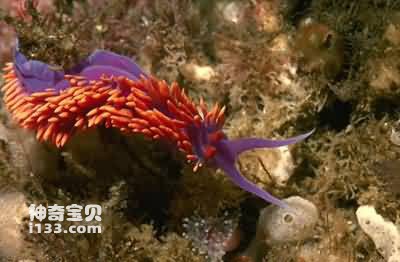
34. Aplysia
Aplysia is a kind of seafood called sea powder. It is not only a good anti-inflammatory and antipyretic medicine, but also rich in nutrients. It is a popular food loved by residents along the coast of Hainan, my country. What is sea powder? It turns out that it is the egg laid by a kind of shellfish, this kind of shellfish is Aplysia. In appearance, Aplysia does look like a rabbit, hence its name. Aplysia is a shellfish that lives in shallow seas. It likes to live in bays with clear water and smooth currents. It is most abundant among seaweeds near the low tide line. They feed on various seaweeds, and their body color and pattern are very similar to the seaweed in their habitat, so they can be well hidden from enemies.
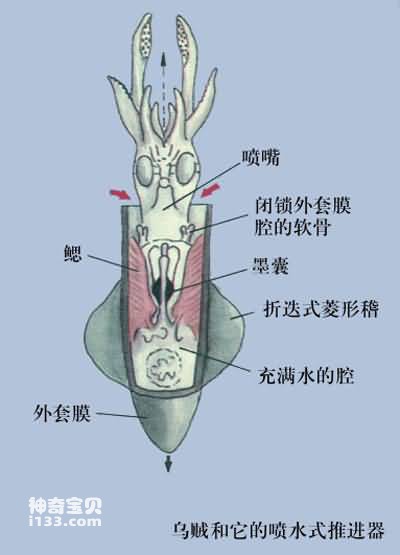
The squid and its water jet

A schematic diagram of the relative length and swimming speed of a squid
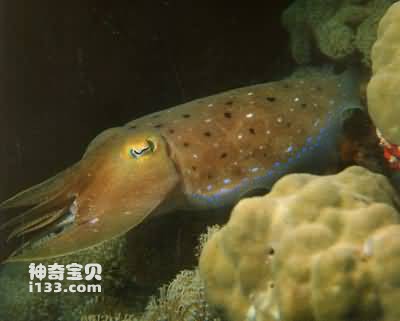
35. Squid
There is an animal in the sea that can spit ink called a bird thief. Because it can spit ink, it is also called cuttlefish. Bird thieves are shellfish, and they are an important representative of the order Cephalopoda. Not only can squids swim in the sea for a long time like fish, but they can also swim very fast. Some people call them "rockets in the sea." This metaphor is very appropriate. Underneath the squid's head, there is a very special organ called a funnel. The funnel is a tapered tube that is also part of the foot. On the one hand, this tube plays the same role as the water tube of clams, and is the outlet for reproductive cells, excretion, respiration, and ink; on the other hand, it is also the movement organ of the squid. Squids can change the color of their bodies at any time, sometimes bright, sometimes dark, sometimes purple, and sometimes other colors. This is because there are many stretchable pigment cells under the squid's skin. There are radial muscle fibers around these pigment cells. Due to the contraction of the muscle fibers, the pigment cells can be enlarged or reduced. Squids often change their body color to adapt to the external environment of different shades of color, and also use it to intimidate their enemies. The squid has a special defense weapon, which is the ink sac inside its body. The ink sac contains thick black ink. When the squid encounters an enemy, it ejects the ink in the ink sac through the funnel. This is like setting off a smoke bomb, completely dyeing the surrounding seawater black so that the enemy cannot see it and thus evade the enemy's attack. The meat of squid is very delicious. Its meat contains a lot of protein and is very nutritious. Therefore, like fish and other shellfish, it has become a good food for us.

36. Calamari
In addition to squid, there are many cephalopods living in the ocean, and they are all fast-swimming species. Among them, squid and calamari are the most famous. Their meat is more delicious than squid, so countries around the world pay great attention to their fishing. Squid, in particular, is abundant along the coasts of North Korea, Japan and other countries. The squid produced in my country is different from those produced in North Korea, Japan and other countries. It is called "squid" in taxonomy.
The head and body of the squid are very long and narrow, especially the trunk, which has a very pointed end and is shaped like the head of a javelin. Moreover, it moves so quickly in the sea, so people call it squid.
Calamari live in areas not too far from the coast. Every spring when they spawn, groups of squid swim near the shore to lay eggs. The eggs are enclosed in a rod-shaped, transparent gelatinous sheath. There are often many rod-shaped egg sheaths connected at the base and attached to rocks or other objects. They are shaped like a white flower, which is very beautiful.
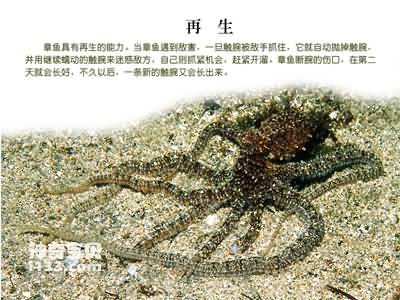
37. Octopus
Like squid, octopus is also a cephalopod because its legs are also on the top of its head. However, it only has eight legs and does not have the special claws used to catch food like squid. Its eight legs are very long, like eight belts, so fishermen call it "octopus".
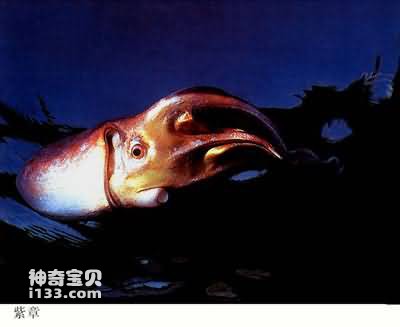
Octopuses are also very ferocious animals. It has large suction cups with strong suction powers on its legs. If we catch a small octopus and hold it in our hand, it will immediately suck our hand with its suction cup, and it will be very laborious to remove it!
The octopus also has ink sacs in its body, and the ink contained in it also contains toxins. It can not only be used to defend against enemies, but also to attack them. A very interesting fact is that when the octopus is resting, it does not rest all at once. Instead, it leaves one or two long legs on duty and keeps turning. Although its body and other legs are relatively dull, if its duty leg is slightly touched, the octopus will immediately jump up and release thick ink to hide itself.
Because the octopus has strong legs and suckers, as well as good defense tools, animals of the same size as it in the ocean will be harmed by it. Even the largest and best-equipped crayfish, with bodies about the same size as an octopus, will inevitably fall victim to it. The meat of octopus is very plump and it is also an excellent seafood.
animal tags:
We created this article in conjunction with AI technology, then made sure it was fact-checked and edited by a Animals Top editor.